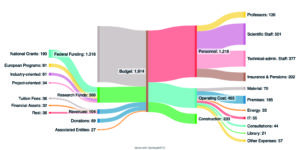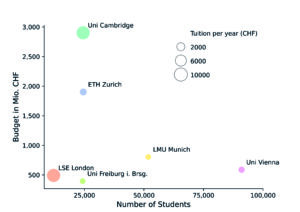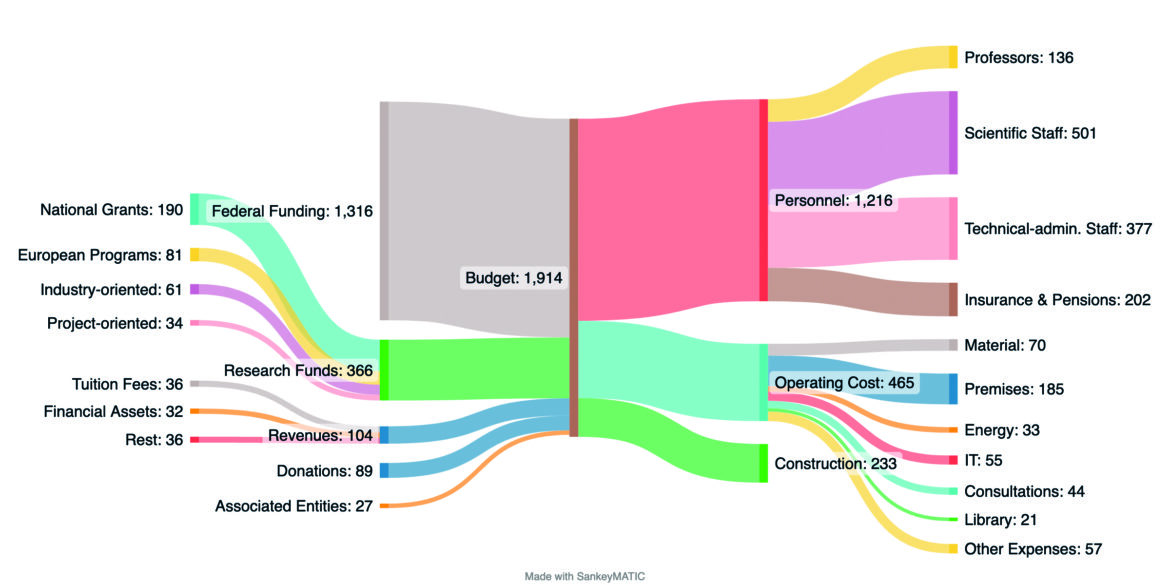by Anna Weber
4 530 students in 16 departments, 6 612 scientific staff in more than 500 research groups, 178 buildings in Zurich alone, and much, much more: ETH is a gigantic undertaking. And of course, that means that large amounts of money are being spent. But how much money is involved, where does it come from and what exactly does ETH spend it all on?
Answers to these questions can be found in the annual report of ETH, which is published every year. Apart from interesting facts and figures, the highlights of the year, and latest ETH news, it also contains a detailed financial report. On the website of ETH, you can find all reports since 2002. For this text, I searched through the report of 2021 to uncover the most interesting financial facts of ETH for you.

The flow of money at ETH Zurich in 2021. The data is adapted from the annual financial report. (Data is given in millions of Swiss francs.)
Budget
First of all, all numbers on the ETH budget are given in millions of Swiss francs – that is the scale that we are talking about. In 2021, the ETH Zurich had a budget of almost 2 billion Swiss francs. That sounds like an awful lot of money. But is it really a lot for a big university? Comparing to a few other European universities shows that the budget of ETH is indeed quite high in relation to the number of students it hosts. The University of Vienna, for example, with almost four times the number of students, has less than a third of the ETH budget. However, some elite universities like Cambridge have even higher budgets. Maybe because the tuition fees for students are so much higher?

Compared to other European universities, ETH Zurich has quite a high budget for the number of students, while also having low tuition fees.
Sources of Income
The state of Switzerland invests a lot of money in its universities. Looking at the income of ETH, we can see that around two thirds are federal funding. The remaining third of the income is mainly so-called third-party funding. This is usually money that research groups are awarded to carry out specific research projects. Again, most of this money comes from the state, in the form of SNSF (Swiss National Science Foundation) grants. Another big chunk comes from European grants, like those awarded by the European Research Council (ERC). Since 2007, ETH has received a total of 540.7 million Swiss francs from ERC alone!
Donations
What surprised me most, is how much money is donated to ETH – in 2021, it was almost 90 million Swiss francs. Who gives that much money to ETH? While most of the details of the donations are not published, everyone who donated over 20 000 Swiss francs is listed at the end of the annual report. For the year 2021, we can find 279 names on that list. 50 of those are private individuals, for example the former rector Prof Dr Lino Guzzella. Another 86 donations come from businesses. Here we find local cooperations like SBB, Swisscom and Coop, but also giants like Google, Shell, Nestlé, Amazon and Apple have donated to the ETH in 2021. The rest of the donations come from various foundations and organisations. To get some more concrete information about specific donations, I contacted Alex Hochuli from the ETH Zürich Foundation. From him, we learn that the highest individual donation in 2021 was the sponsorship of the professorship “Nuclear Systems and Multiphase Flows” for 15 million Swiss francs, half of which came from the Swiss Federal Office for Energy, the other half from swissnuclear.
Spending
he most valuable asset of ETH are the people who work there – or at least that is what the spending would suggest. Almost two thirds of the budget is spent on salaries. Have you ever wondered what an ETH professor earns? Well, with 526.9 professors sharing around 136 million Swiss rancs per year, it is easy to calculate: The average salary of an ETH professor is around 258 000 Swiss francs per year. But of course, ETH also has a ton of other expenses. A surprisingly large sum of money is spent on libraries – which might be connected to the high prices that scientific journals ask for accessing their literature.
But ETH isn’t just running – it is also expanding. Therefore, large sums of money are invested in construction every year. In 2021, more than half of that cost was spent on the new buildings GLC in Zürich Zentrum and BSS in Basel, as well as on renovating the HIF at Hönggerberg and the ML/FHK in Zentrum, which among other things hosts the new Student Project House.
Costs of studying
While of course a lot of money at ETH is spent on research, it also costs a lot to educate students. But how much exactly? An answer to that comes from Markus Knaus, head of Controlling at ETH. He states that each student of the exact sciences costs approximately 16 000 Swiss francs per year to educate, those of mechanical and electrical engineering even 23 000 Swiss francs. With that in mind, the tuition fee of 730 Swiss francs per semester doesn’t sound that high anymore. In total, the tuition fees add up to roughly 36 million Swiss francs of income for ETH. A lot of money! But in the total budget of ETH, it almost looks like peanuts.
Anna Weber, 30,
is used to digging through data thanks
to her PhD in bioinformatics, but has never
read a financial report before.

